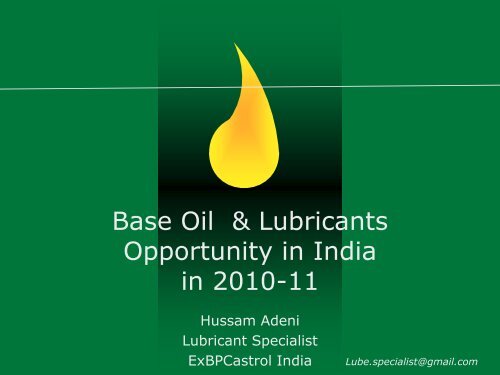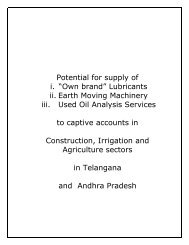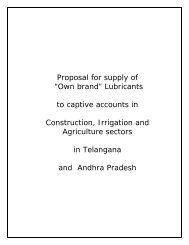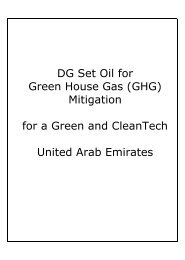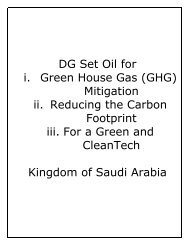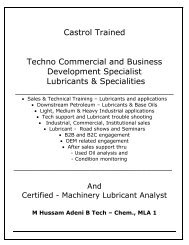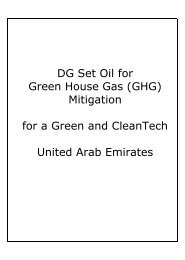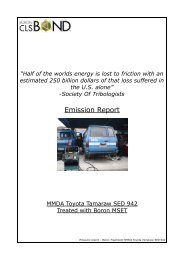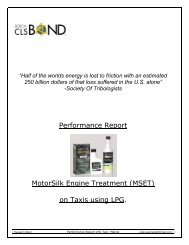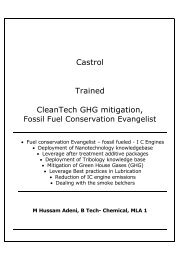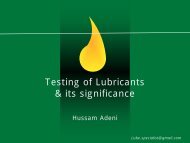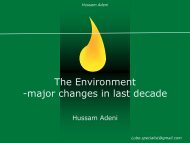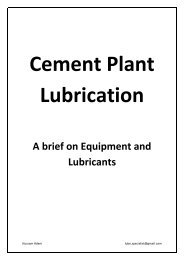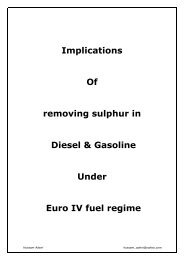Base Oil & Lubricants Opportunity in India in 2010-11
Opportunity for Base Oil and for Lubricants in India 20010-11
Opportunity for Base Oil and for Lubricants in India 20010-11
Create successful ePaper yourself
Turn your PDF publications into a flip-book with our unique Google optimized e-Paper software.
<strong>Base</strong> <strong>Oil</strong> & <strong>Lubricants</strong><br />
<strong>Opportunity</strong> <strong>in</strong> <strong>India</strong><br />
<strong>in</strong> <strong>2010</strong>-<strong>11</strong><br />
Hussam Adeni<br />
Lubricant Specialist<br />
ExBPCastrol <strong>India</strong><br />
Lube.specialist@gmail.com
Contents<br />
Component of the <strong>India</strong> Lube Market<br />
The <strong>India</strong> Lubricant <strong>in</strong>dustry<br />
The <strong>India</strong> <strong>Base</strong> <strong>Oil</strong> Industry<br />
The <strong>India</strong> Lube additives Industry<br />
<strong>Base</strong> oil manufactur<strong>in</strong>g<br />
Hussam Adeni – Lube Specialist
The components<br />
for the <strong>India</strong><br />
Lubricant market<br />
Lube.specialist@gmail.com
The Components -<br />
for the <strong>India</strong> Market<br />
• <strong>India</strong> – An opportunities galore<br />
• Vehicles <strong>in</strong> <strong>India</strong><br />
• Production<br />
• Population<br />
• Fuel consumption<br />
• Geographical size<br />
• Lube market<br />
• Hussam Adeni – Lube specialist<br />
Hussam Adeni<br />
Lube.specialist@gmail.com
<strong>India</strong> – Opportunities galore<br />
2009-10<br />
• Third largest market <strong>in</strong> the world<br />
• Second largest market <strong>in</strong> Asia<br />
Pacific<br />
• Ranks after Ch<strong>in</strong>a and Japan<br />
• <strong>India</strong> market 1,900 million litres<br />
Hussam Adeni<br />
Lube.specialist@gmail.com
<strong>India</strong> – Opportunities galore<br />
2009-10 - Economy<br />
• Area<br />
3.28 sq km<br />
• Population 1.166 million<br />
• Population density 354.7/ sq km<br />
• Vehicle population <strong>11</strong>4.9 million<br />
• 2 wheelers 82.5 million<br />
• Trucks & Buses 6.5 million<br />
• Cars<br />
15.0 million<br />
• Others<br />
10.9 million<br />
Hussam Adeni<br />
Lube.specialist@gmail.com
Vehicle population 2009-10<br />
• Total vehicle population <strong>11</strong>4.9<br />
million<br />
• 2 wheeler contribute about three<br />
fourths of the vehicle population<br />
• Approx. 72% vehicles are 2 wheelers<br />
• Used for multiple purpose<br />
• Personal and Public passenger transport<br />
• Personal & Public goods transport<br />
Hussam Adeni<br />
Lube.specialist@gmail.com
Vehicle population – 2009-10<br />
• Total vehicle population <strong>11</strong>4.9<br />
million<br />
• Approx. 72% vehicles are 2 wheeler<br />
• Passenger cars account for 13%<br />
• Buses and Trucks account for 5.6%<br />
Hussam Adeni<br />
Lube.specialist@gmail.com
Vehicle population 2009-10<br />
• 72% vehicles - 2 wheeler<br />
• 13% vehicles – Passenger cars<br />
• 9.5% vehicles – Other<br />
• 5.6% vehicles – Buses and Trucks<br />
Total vehicle population <strong>11</strong>4.9<br />
million<br />
Hussam Adeni<br />
Lube.specialist@gmail.com
Vehicle population 2009-10<br />
• 82.5 million - 2 wheeler<br />
• 15 million - Passenger cars<br />
• 10.9 million - Others<br />
• 6.5 million – Buses and Trucks<br />
Total vehicle population <strong>11</strong>5<br />
million<br />
Hussam Adeni<br />
Lube.specialist@gmail.com
Motor Fuel demand <strong>in</strong> <strong>India</strong><br />
• Major Fuels<br />
• Gasol<strong>in</strong>e or Motor spirit ( called<br />
Petrol)<br />
• Diesel – HSD ( High Speed Diesel)<br />
• LPG – Gas vehicles<br />
• CNG - Gas vehicles<br />
• Demand for Gas likely to pick up<br />
Hussam Adeni<br />
Lube.specialist@gmail.com
Motor Fuel demand <strong>in</strong> <strong>India</strong><br />
• Major Fuels<br />
• Gasol<strong>in</strong>e or Motor spirit ( called<br />
Petrol)<br />
•Consumption – 12.5 million tons<br />
Hussam Adeni<br />
Lube.specialist@gmail.com
Motor Fuel demand <strong>in</strong> <strong>India</strong><br />
• Major Fuels<br />
• Diesel – High Speed Diesel<br />
•Consumption – 55.1 million tons<br />
• An estimated 2% probably<br />
used to “adulterate” gasol<strong>in</strong>e<br />
Hussam Adeni<br />
Lube.specialist@gmail.com
Motor Fuel demand <strong>in</strong> <strong>India</strong><br />
• Major Fuels<br />
•LPG – Liquefied Petroleum Gas<br />
• Allocated for domestic use <strong>in</strong><br />
cook<strong>in</strong>g and carries subsidies<br />
•CNG – Compressed Natural Gas<br />
• Retailed at Gujarat and Delhi<br />
• Demand pick<strong>in</strong>g up due to lower costs.<br />
• Consumption data negligible but mixed<br />
up with non transport use<br />
Hussam Adeni<br />
Lube.specialist@gmail.com
Environmental issue<br />
- Motor fuels<br />
• Diesel – Sulphur content<br />
• Till Jan 2000 – 2500 ppm Nationwide<br />
• Urban centres – 500 ppm<br />
• By 2005 - 500 ppm Nationwide<br />
• By <strong>2010</strong> - 250 ppm Nationwide<br />
• Apr <strong>2010</strong> - 50 ppm <strong>11</strong> Cities<br />
Hussam Adeni<br />
Lube.specialist@gmail.com
Environmental issue<br />
- Motor fuels<br />
• Gasol<strong>in</strong>e – Sulphur content<br />
• Till Jan 2000 – 1000 ppm Nationwide<br />
• Urban centres – 500 ppm<br />
• By 2005 - 500 ppm Nationwide<br />
• By <strong>2010</strong> - 150 ppm Nationwide<br />
• Apr <strong>2010</strong> - 50 ppm <strong>11</strong> Cities<br />
Hussam Adeni<br />
Lube.specialist@gmail.com
The <strong>India</strong><br />
Lubricant market<br />
Lube.specialist@gmail.com
Lube consumption<br />
- Major sectors – 2009-10<br />
• <strong>India</strong> Lube market 1,900 m*<br />
• Transport Sector - 52%<br />
• Non Transport sector - 47.9%<br />
* Lube market - 2009-10 : 1.900 million litres<br />
Hussam Adeni<br />
Lube.specialist@gmail.com
Lube consumption<br />
- Major sectors<br />
• <strong>India</strong> Lube market 1,900 m*<br />
• Transport Sector - 52%<br />
•Diesel Lubes is 70%<br />
•Petrol Lubes is 30%<br />
• Non Transport sector - 48%<br />
• Industrial<br />
• Ma<strong>in</strong>tenance, Process, Manufactur<strong>in</strong>g<br />
Hussam Adeni<br />
Lube.specialist@gmail.com
Lube consumption<br />
- Transport sectors<br />
• <strong>India</strong> Lube market 1,900 m*<br />
• Transport Sector - 52% 983 million Lt<br />
• Passenger cars – 2<strong>11</strong> million Lt<br />
• 2 & 3 wheelers – 145 million Lt<br />
• Trucks & buses – 313 million Lt<br />
• Agriculture/Tractor – 60 million Lt<br />
• Railroad <strong>Oil</strong>s - 64 million Lt<br />
• Mar<strong>in</strong>e eng/DG Sets – 69 million Lt<br />
• Auto transmsn fluids – 69 million Lt<br />
• Others<br />
- 40 million Lt<br />
Hussam Adeni<br />
Lube.specialist@gmail.com
Lube consumption<br />
- Non Transport sectors<br />
• <strong>India</strong> Lube market 1,900 m*<br />
• Non Transport Sector - 47.9%<br />
• Approx 902 million Lt<br />
• Industrial oils – 762 million Lt<br />
• Greases - 95 million Lt<br />
• Others<br />
- 45 million Lt<br />
Hussam Adeni<br />
Lube.specialist@gmail.com
Lubricant<br />
- Market shares <strong>in</strong> %<br />
• <strong>India</strong>n <strong>Oil</strong> 24%<br />
• H<strong>in</strong>dustan Petroleum 12%<br />
• BPCastrol 10%<br />
• Bharat Petroleum <strong>11</strong>%<br />
• Others 17%<br />
• Shell 5.0%<br />
• Valvol<strong>in</strong>e & Valvol<strong>in</strong>e 3.2%<br />
• Total 3.0 %<br />
Hussam Adeni<br />
Lube.specialist@gmail.com
Lubricant<br />
- Market shares <strong>in</strong> % & Mil. Lt<br />
• <strong>India</strong>n <strong>Oil</strong><br />
24% - 449 m Lt<br />
H<strong>in</strong>d Petroleum 12% - 215 m Lt<br />
• BPCastrol<br />
• Bharat Petro<br />
10% - 184 m Lt<br />
<strong>11</strong>% - 196 m Lt<br />
• Others 17%<br />
• Shell<br />
5.0% - 90 m Lt<br />
• Valvol<strong>in</strong>e & Tidewater 3.2% - 60 m Lt/each<br />
• Total<br />
3.0 % - 56 m Lt<br />
Hussam Adeni<br />
Lube.specialist@gmail.com
Lubricant<br />
- Annual Blend<strong>in</strong>g capacities<br />
• <strong>India</strong>n <strong>Oil</strong><br />
430 million Lt<br />
H<strong>in</strong>dustan Petroleum 350 million Lt<br />
• BPCastrol<br />
300 million Lt<br />
• Bharat Petroleum 125 million Lt<br />
• Others<br />
395 million Lt<br />
Total capacity: 1600 million Lt/Year<br />
Hussam Adeni<br />
Lube.specialist@gmail.com
The <strong>Base</strong> <strong>Oil</strong>s<br />
Industry<br />
Lube.specialist@gmail.com
<strong>Base</strong> oil manufactur<strong>in</strong>g<br />
• Group I<br />
• - Capacity 805 million Lt/Yr<br />
• - More than 990 million Lt/Yr imported<br />
• Group II*<br />
- Capacity 460 million Lt/Yr<br />
• Group III<br />
- Nil<br />
* BPCL Mumbai: 150 m/Lt Yr Hydro-crack<strong>in</strong>g unit executed.<br />
and on stream on 1 st Qtr 2006<br />
Hussam Adeni<br />
Lube.specialist@gmail.com
<strong>Base</strong> oil manufactur<strong>in</strong>g<br />
• Group I<br />
• - Capacity 850 million Lt/Yr<br />
• H<strong>in</strong>d Petroleum – 200 million Lt<br />
• Mumbai Ref<strong>in</strong>ery<br />
• IOC -<br />
200 million Lt<br />
• Haldia<br />
• IOC L /Madras Petro - 270 million Lt<br />
• Chennai<br />
• BPCL<br />
- 180 million Lt<br />
• Chennai<br />
Hussam Adeni<br />
Lube.specialist@gmail.com
Target Market – <strong>Base</strong> <strong>Oil</strong>s<br />
• Group I<br />
• - Shortfall is 850 million Lt<br />
• - Met by imports from<br />
• Iran<br />
• Dubai ( Traded)<br />
• Other Middle East countries<br />
• Far East and Aspac<br />
Hussam Adeni<br />
Lube.specialist@gmail.com
<strong>Base</strong> oil manufactur<strong>in</strong>g<br />
• Group II<br />
• - Capacity 460 million Lt/Yr<br />
• H<strong>in</strong>d Petroleum –<br />
• Mumbai Ref<strong>in</strong>ery<br />
• IOC -<br />
• Haldia<br />
• BPCL<br />
• Chennai<br />
150 million Lt<br />
140 million Lt<br />
- 170 million Lt<br />
Hussam Adeni<br />
Lube.specialist@gmail.com
<strong>Base</strong> oil - Supply & demand<br />
2006 - 2009<br />
Source 2006 2007 2008 2009<br />
Market<br />
Reqd.<br />
Local<br />
supply<br />
Shortfall<br />
Hence<br />
Imported<br />
1544 1690 1712 1900<br />
863 1030 967 989<br />
681 660 750 850<br />
Hussam Adeni<br />
Lube.specialist@gmail.com
<strong>Base</strong> <strong>Oil</strong> - Grade<br />
Pric<strong>in</strong>g Hyderabad – <strong>in</strong> INR<br />
IOC/HP - Ex Mumbai/Chennai Apr 20<strong>11</strong><br />
IOC/HP<br />
or ExChennai<br />
Group I<br />
Per Lt <strong>in</strong> bulk<br />
Group II<br />
Per Lt <strong>in</strong> bulk<br />
Ex Mumbai<br />
SN 100 60 - 62 62 - 65<br />
SN 150 60 - 62 63 - 66<br />
SN 500 60 - 62 _____<br />
BS 150 80 - 82 ______<br />
Payment terms<br />
Pack<strong>in</strong>g<br />
Freight<br />
Advance DD/Cheque<br />
20 KL tankers<br />
2.00/Lt ExMumbai, 1.50/Lt ExChennai<br />
Hussam Adeni<br />
Lube.specialist@gmail.com
The Lubricant<br />
Additive Industry<br />
Lube.specialist@gmail.com
Additive manufactur<strong>in</strong>g<br />
• Capacity 55 million Kg/Yr<br />
• Lubrizol<br />
• - Mumbai<br />
• <strong>India</strong>n Additives<br />
• - Chennai<br />
Hussam Adeni<br />
Lube.specialist@gmail.com
Additive manufactur<strong>in</strong>g<br />
• Capacity 55 million Kg/Yr<br />
• Lubrizol<br />
• 50% JV – IOC & Lubrizol USA<br />
• 45 million Kg/Yr<br />
• - Mumbai<br />
Hussam Adeni<br />
Lube.specialist@gmail.com
Additive manufactur<strong>in</strong>g<br />
• Capacity 55 million Kg/Yr<br />
• Lubrizol<br />
• 50% JV – IOC & Lubrizol USA<br />
• 45 million Kg/Yr<br />
• Mumbai<br />
• <strong>India</strong>n Additives<br />
• 50% JV IOC & Chevron Oronite<br />
• 15 million Kg/Yr<br />
• - Chennai<br />
Hussam Adeni<br />
Lube.specialist@gmail.com
How <strong>Base</strong> <strong>Oil</strong>s<br />
are manufactured<br />
Lube.specialist@gmail.com
How are <strong>Base</strong> <strong>Oil</strong>s made<br />
• By far, the bulk of lubricants are blended from<br />
petroleum base-stocks.<br />
• The start<strong>in</strong>g po<strong>in</strong>t is Crude <strong>Oil</strong><br />
• Crude oil or petroleum is the term for "unprocessed"<br />
oil<br />
• Crude oil is a fossil fuel, mean<strong>in</strong>g that it was<br />
naturally made from decay<strong>in</strong>g animals & plants<br />
liv<strong>in</strong>g <strong>in</strong> ancient seas millions of years ago.<br />
• Anywhere you f<strong>in</strong>d crude oil was once a sea bed.<br />
• Crude <strong>Oil</strong> colour varies from clear to tar-black & it<br />
ranges from water-like to almost solid<br />
Hussam Adeni<br />
Lube.specialist@gmail.com
How are <strong>Base</strong> <strong>Oil</strong>s made<br />
TYPICAL COMPOSITION (weight %)<br />
– Carbon 84%<br />
– Hydrogen 14%<br />
– Sulphur 1- 5%<br />
– Other (Nitrogen, Oxygen, Metals, Salts)<br />
Distillation process<br />
• A ref<strong>in</strong>ery process known as Atmospheric<br />
Distillation boils off all the low-boil<strong>in</strong>g<br />
materials which are then condensed and<br />
used as fuels.<br />
• A second distillation process, Vacuum<br />
Distillation, under reduced pressure produces<br />
high boil<strong>in</strong>g fractions -vacuum gas oils -<br />
known as “Feeds”.<br />
Hussam Adeni<br />
Lube.specialist@gmail.com
The Distillation Process<br />
“Feeds”.<br />
Ris<strong>in</strong>g vapours<br />
condense and<br />
are drawn off<br />
The value of crude<br />
oil can only be<br />
realized once it<br />
has been cleaned<br />
up (de-watered<br />
and de-salted) and<br />
separated <strong>in</strong>to<br />
various fractions of<br />
similar<br />
hydrocarbons.<br />
Hussam Adeni<br />
Lube.specialist@gmail.com
Typical yields<br />
• The Average production from a barrel of crude oil is:<br />
• Gasol<strong>in</strong>e 44%<br />
• Distillate (home heat, diesel) 21%<br />
• Kerosene-type jet fuel 9%<br />
• Other (e.g., residual fuel oil, coke, asphalt) 25%<br />
• Lubricant feedstock 1%<br />
• So-called “Lube Crudes” will yield higher amounts of the vacuum<br />
distillates that go to make up lubricant Feedstocks, or “Feeds”.<br />
• Feeds are the start<strong>in</strong>g po<strong>in</strong>t for produc<strong>in</strong>g <strong>Base</strong> Stock<br />
Hussam Adeni<br />
Lube.specialist@gmail.com
What is <strong>Base</strong> stock<br />
• <strong>Base</strong> Stocks are the<br />
ref<strong>in</strong>ed oils (derived from<br />
crude oil) which are<br />
blended together with<br />
additives to produce a<br />
f<strong>in</strong>ished lubricant.<br />
• <strong>Base</strong> <strong>Oil</strong>s are complex<br />
mixtures of hydrocarbons<br />
• The actual composition is<br />
<strong>in</strong>fluenced by the ref<strong>in</strong><strong>in</strong>g<br />
technology used<br />
Hussam Adeni<br />
Lube.specialist@gmail.com
Types of <strong>Base</strong> stock<br />
• <strong>Base</strong>-Stocks of different viscosities are the<br />
fundamental build<strong>in</strong>g blocks of f<strong>in</strong>ished lubricants.<br />
• The processes to make base-stocks can be<br />
relatively mild, simple & straightforward as <strong>in</strong> the<br />
case of older style Solvent Ref<strong>in</strong>ed (API Group 1)<br />
base-stocks, or:<br />
• They may be quite complex and severe <strong>in</strong> terms of<br />
their process conditions, as is the case Hydro-<br />
Treated and Hydro-Cracked base-stocks (API<br />
Groups 2 and 3)<br />
Hussam Adeni<br />
Lube.specialist@gmail.com
API Groups<br />
• The American Petroleum Institute (API) has<br />
developed numerical classifications (API <strong>Base</strong><br />
Stock Groups) for lubricant base stocks, based on<br />
– Sulphur content,<br />
–composition,<br />
–VI.<br />
Hussam Adeni<br />
Lube.specialist@gmail.com
API Groups –Typical values<br />
Group Wt %<br />
Sulphur<br />
Wt %<br />
Saturates<br />
VI<br />
I › 0.03 ‹ 90 80 - 100<br />
II ‹ 0.03 › 90 80 - <strong>11</strong>9<br />
III ‹ 0.03 › 90 120+<br />
IV<br />
V<br />
Synthetic POA<br />
Other synthetics ( Diesters,PAG,)<br />
Hussam Adeni<br />
Lube.specialist@gmail.com
API Groups<br />
• Why do we “slot” base stocks <strong>in</strong>to API groups?<br />
• Remember that base stock is a key build<strong>in</strong>g<br />
block of the f<strong>in</strong>al lubricant .<br />
• Group designations are a guidel<strong>in</strong>e to<br />
applications and formulation requirements<br />
Hussam Adeni<br />
Lube.specialist@gmail.com
The API Group I <strong>Base</strong> <strong>Oil</strong>s<br />
• Group I:<br />
Is the lowest quality level with viscosity<br />
<strong>in</strong>dexes (VIs) <strong>in</strong> the range 80-100+, but<br />
usually below 100. Solvent ref<strong>in</strong>ed base<br />
stocks fall <strong>in</strong>to this category.<br />
Hussam Adeni<br />
Lube.specialist@gmail.com
The API Group I <strong>Base</strong> <strong>Oil</strong>s<br />
• The older ref<strong>in</strong><strong>in</strong>g processes <strong>in</strong>volved little or no<br />
chemical alteration of the crude oil components.<br />
• They <strong>in</strong>volved removal by distillation the light and<br />
heavy portions of the crude oil which are not of any use<br />
for lubes, and then remov<strong>in</strong>g the impurities and<br />
undesirable wax from the rema<strong>in</strong>der by a process<br />
called “Solvent Ref<strong>in</strong><strong>in</strong>g” (SR).<br />
• Solvent was percolated through the oil to remove<br />
impurities, and the oil then chilled to low temperature<br />
with a second solvent to remove wax as an <strong>in</strong>soluble<br />
solid which could be filtered off.<br />
Hussam Adeni<br />
Lube.specialist@gmail.com
The API Group I <strong>Base</strong> <strong>Oil</strong>s<br />
• The result<strong>in</strong>g oils still conta<strong>in</strong> significant<br />
amounts of coloured impurities, as well as<br />
dissolved waxes.<br />
• These oils are only moderately stable by modern<br />
standards, suffer from poorer physical properties<br />
(e.g.low-temperature viscosity, high temperature<br />
volatility) and VI values were modest.<br />
• This process produces API Group I base<br />
oils<br />
Hussam Adeni<br />
Lube.specialist@gmail.com
The API Group II <strong>Base</strong> <strong>Oil</strong>s<br />
• Group II & II+:<br />
Applies to base stocks with low impurity levels,<br />
and VIs from 80 to 100. Most HT base stocks<br />
are Group II and have typical VIs of 95-105.<br />
Products with VIs <strong>in</strong> the <strong>11</strong>0 to <strong>11</strong>9 range are<br />
sometimes referred to as Group II+ to<br />
dist<strong>in</strong>guish them from other Group II products.<br />
HC/IDW base stocks are Group II+, with the<br />
rema<strong>in</strong>der be<strong>in</strong>g Group III<br />
Hussam Adeni<br />
Lube.specialist@gmail.com
The API Group II <strong>Base</strong> <strong>Oil</strong>s<br />
• API Group II & Group III base stocks are<br />
manufactured by means of processes called severe<br />
Hydro-Treat<strong>in</strong>g (HT) & Hydro-Crack<strong>in</strong>g (HC).<br />
• HT base stocks fall under the def<strong>in</strong>ition of API Group II.<br />
• Hydro-Cracked /IDW base stocks are API Group II+/III.<br />
• After the <strong>in</strong>itial separation of the crude oil by<br />
distillation, the above two processes are used to<br />
chemically alter and improve the base-stock<br />
molecules.<br />
Hussam Adeni<br />
Lube.specialist@gmail.com
The API Group II,II+,III<br />
• Both processes subject the oil fractions to<br />
hydrogen gas under high-temperature, highpressure<br />
conditions over a catalyst<br />
• The result<strong>in</strong>g lube oils still conta<strong>in</strong> undesirable<br />
wax at this stage. It may be removed by<br />
• Typical solvent dewax<strong>in</strong>g,<br />
• or by a modern process known as Iso dewax<strong>in</strong>g (IDW)<br />
• or Hydro-Isomerisation, which is highly effective.<br />
Hussam Adeni<br />
Lube.specialist@gmail.com
The API Group II <strong>Base</strong> <strong>Oil</strong>s<br />
• Group II & II+:<br />
• Applies to base stocks with low impurity levels,<br />
and VIs from 80 to 100. Most HT base stocks<br />
are Group II and have typical VIs of 95-105.<br />
Products with VIs <strong>in</strong> the <strong>11</strong>0 to <strong>11</strong>9 range are<br />
sometimes referred to as Group II+ to<br />
dist<strong>in</strong>guish them from other Group II products.<br />
HC/IDW base stocks are Group II+, with the<br />
rema<strong>in</strong>der be<strong>in</strong>g Group III<br />
Hussam Adeni<br />
Lube.specialist@gmail.com
HT and HC base oils<br />
• The result<strong>in</strong>g oils from these processes are<br />
water-white, and over 99% pure <strong>in</strong> terms of<br />
hydrocarbon content.<br />
• Undesirable impurities, such as<br />
• Sulphur,<br />
• Nitrogen,<br />
• and Oxygen compounds,<br />
are either completely absent, or are present <strong>in</strong><br />
trace amounts <strong>in</strong> ppm (parts per million).<br />
Hussam Adeni<br />
Lube.specialist@gmail.com
HT, HC & Isodewaxed oils<br />
• In the case of Iso-DeWaxed (IDW) oils, the wax<br />
has been chemically converted to very useful<br />
lubricant with excellent low temperature<br />
properties.<br />
• Thus, for both HT and HC/IDW, the base<br />
stocks produced are much more stable with<br />
lower wax content, good low temp properties,<br />
and improved volatility characteristics.<br />
VI values for HT tend to be High. For HC/IDW,<br />
they are Very High- hence VHVI.<br />
Hussam Adeni<br />
Lube.specialist@gmail.com
The API Group III and IV<br />
• Group III & IV:<br />
• Group III: Applies to base stocks of saturated<br />
hydrocarbon composition, very low impurity levels, and<br />
very high VI (VHVI), above 120. <strong>Lubricants</strong> formulated<br />
from Group III base stocks can be referred to as<br />
synthetic. Select HC/IDW base stocks fall <strong>in</strong>to this<br />
category.<br />
• Group IV: Refers to fully synthetic base stocks,<br />
(e.g.PAOs).<br />
Hussam Adeni<br />
Lube.specialist@gmail.com
<strong>India</strong> – Opportunities galore<br />
2009-10<br />
• Third largest market <strong>in</strong> the world<br />
• Second largest market <strong>in</strong> Asia<br />
Pacific<br />
• Ranks after Ch<strong>in</strong>a and Japan<br />
• <strong>India</strong> market 1,900 million litres<br />
• Lube market worth INR 285,000<br />
million<br />
Hussam Adeni<br />
Lube.specialist@gmail.com
<strong>India</strong> – An opportunities galore<br />
based on 2009-10 data<br />
Thank you<br />
Hussam Adeni<br />
Lube.specialist@gmail.com
Hussam Adeni<br />
– Lube Specialist<br />
Web l<strong>in</strong>ks & certifications<br />
Slideshare: http://slidesha.re/tB0M3Q<br />
Blogs Wordpress: http://bit.ly/uCpfw6


